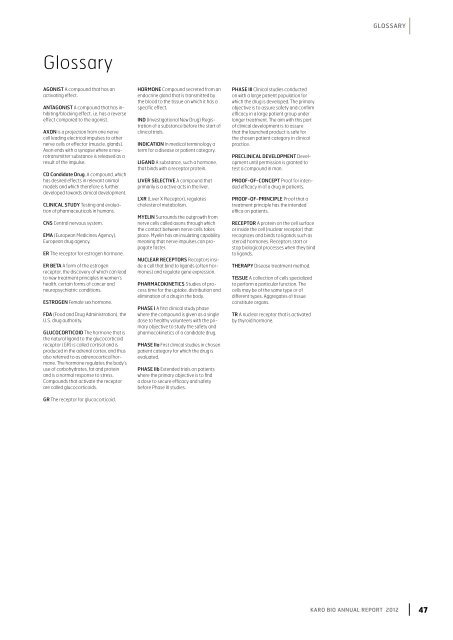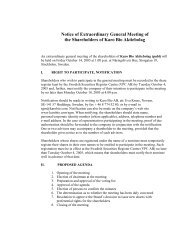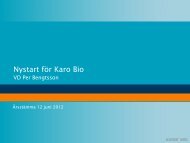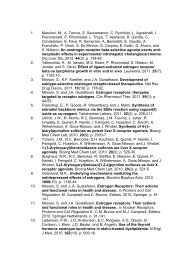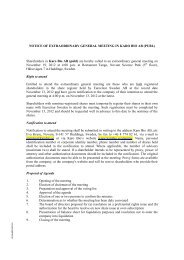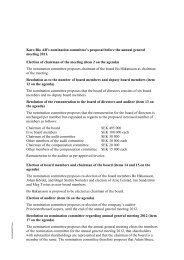Annual Report 2012.pdf - Karo Bio
Annual Report 2012.pdf - Karo Bio
Annual Report 2012.pdf - Karo Bio
Create successful ePaper yourself
Turn your PDF publications into a flip-book with our unique Google optimized e-Paper software.
Glossary<br />
Glossary<br />
AGONIST A compound that has an<br />
activating effect.<br />
ANTAGONIST A compound that has inhibiting/blocking<br />
effect, i.e. has a reverse<br />
effect compared to the agonist.<br />
AXON is a projection from one nerve<br />
cell leading electrical impulses to other<br />
nerve cells or effector (muscle, glands).<br />
Axon ends with a synapse where a neurotransmitter<br />
substance is released as a<br />
result of the impulse.<br />
CD Candidate Drug. A compound, which<br />
has desired effects in relevant animal<br />
models and which therefore is further<br />
developed towards clinical development.<br />
CLINICAL STUDY Testing and evaluation<br />
of pharmaceuticals in humans.<br />
CNS Central nervous system.<br />
EMA (European Medicines Agency),<br />
European drug agency.<br />
ER The receptor for estrogen hormone.<br />
ER BETA A form of the estrogen<br />
receptor, the discovery of which can lead<br />
to new treatment principles in women’s<br />
health, certain forms of cancer and<br />
neuropsychiatric conditions.<br />
ESTROGEN Female sex hormone.<br />
FDA (Food and Drug Administration), the<br />
U.S. drug authority.<br />
GLUCOCORTICOID The hormone that is<br />
the natural ligand to the glucocorticoid<br />
receptor (GR) is called cortisol and is<br />
produced in the adrenal cortex, and thus<br />
also referred to as adrenocortical hormone.<br />
The hormone regulates the body’s<br />
use of carbohydrates, fat and protein<br />
and is a normal response to stress.<br />
Compounds that activate the receptor<br />
are called glucocorticoids.<br />
GR The receptor for glucocorticoid.<br />
HORMONE Compound secreted from an<br />
endocrine gland that is transmitted by<br />
the blood to the tissue on which it has a<br />
specific effect.<br />
IND (Investigational New Drug) Registration<br />
of a substance before the start of<br />
clinical trials.<br />
INDICATION In medical terminology a<br />
term for a disease or patient category.<br />
LIGAND A substance, such a hormone,<br />
that binds with a receptor protein.<br />
LIVER SELECTIVE A compound that<br />
primarily is a active acts in the liver.<br />
LXR (Liver X Receptor), regulates<br />
cholesterol metabolism.<br />
MYELIN Surrounds the outgrowth from<br />
nerve cells called axons through which<br />
the contact between nerve cells takes<br />
place. Myelin has an insulating capability<br />
meaning that nerve impulses can propagate<br />
faster.<br />
NUCLEAR RECEPTORS Receptors inside<br />
a cell that bind to ligands (often hormones)<br />
and regulate gene expression.<br />
PHARMACOKINETICS Studies of process<br />
time for the uptake, distribution and<br />
elimination of a drug in the body.<br />
PHASE I A first clinical study phase<br />
where the compound is given as a single<br />
dose to healthy volunteers with the primary<br />
objective to study the safety and<br />
pharmacokinetics of a candidate drug.<br />
PHASE IIa First clinical studies in chosen<br />
patient category for which the drug is<br />
evaluated.<br />
PHASE IIb Extended trials on patients<br />
where the primary objective is to find<br />
a dose to secure efficacy and safety<br />
before Phase III studies.<br />
PHASE III Clinical studies conducted<br />
on with a large patient population for<br />
which the drug is developed. The primary<br />
objective is to assure safety and confirm<br />
efficacy in a large patient group under<br />
longer treatment. The aim with this part<br />
of clinical development is to assure<br />
that the launched product is safe for<br />
the chosen patient category in clinical<br />
practice.<br />
PRECLINICAL DEVELOPMENT Development<br />
until permission is granted to<br />
test a compound in man.<br />
PROOF-OF-CONCEPT Proof for intended<br />
efficacy in of a drug in patients.<br />
PROOF-OF-PRINCIPLE Proof that a<br />
treatment principle has the intended<br />
effica on patients.<br />
RECEPTOR A protein on the cell surface<br />
or inside the cell (nuclear receptor) that<br />
recognizes and binds to ligands such as<br />
steroid hormones. Receptors start or<br />
stop biological processes when they bind<br />
to ligands.<br />
THERAPY Disease treatment method.<br />
TISSUE A collection of cells specialized<br />
to perform a particular function. The<br />
cells may be of the same type or of<br />
different types. Aggregates of tissue<br />
constitute organs.<br />
TR A nuclear receptor that is activated<br />
by thyroid hormone.<br />
KARO BIO <strong>Annual</strong> <strong>Report</strong> 2012 47


